A culture of collaboration
Bioengineering faculty pivot diagnostics research to support the need for COVID-19 testing
By: Chelsea Yates
Photos: University of Washington
Top image: Research scientist Sujatha Kumar holds a SARS-CoV-2 sample about to be tested in the Yager Lab.
In January 2020, UW research scientist Enos Kline followed news about a new strain of coronavirus emerging in Wuhan, China. It looked bad.
Kline specializes in assay architecture — designing the chemistry and user strategy for medical diagnostic tests – and worked in associate professor of bioengineering (BioE) Barry Lutz’s lab. He asked to begin a small project on the chemistry of this new virus.
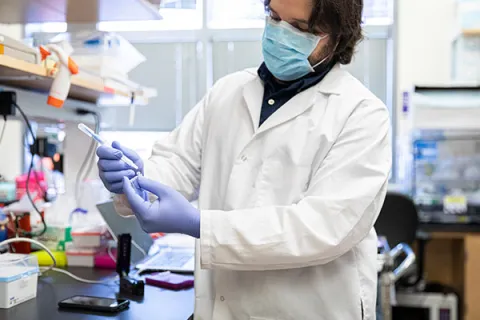
“Our lab develops point-of-care testing devices to diagnose flu and HIV, so it made sense,” Lutz explains.
There wasn’t much known about the disease, now known as COVID-19, but the genomic sequence of the virus that causes it – SARS-CoV-2 – was known, and the sequence could be used to design a test for the virus.
“We thought that if we could pivot technology from our flu and HIV tests to respond to this virus, we could get something out there that could help,” Kline says.
As the virus spread, researchers across campus pivoted their work in response. Nearly 40 percent of BioE’s faculty initiated COVID-19 projects.
With COVID-19, testing is critical regardless of how quickly a vaccine is developed. Like Lutz’s team, BioE professor Paul Yager’s research group also went to work transitioning their diagnostics technology to focus on the virus. Both teams’ tests offer simpler and faster alternatives to traditional COVID-19 tests, which take a few hours to a few days to get reliable results.
“Though we’re working on different technical approaches, we share the goal of developing affordable and widely accessible tests,” Lutz says.
That’s not all the two professors share. “Paul was on my Ph.D. committee, and I learned about point-of-care diagnostics as a research professor in his lab. I think of him as my academic father,” says Lutz, who received his Ph.D. in chemical engineering from the UW in 2003. Since that time, Lutz and Yager have worked together on several projects, establishing a culture of collaboration across their labs, and pushing their work — and diagnostics technology — forward in new directions.
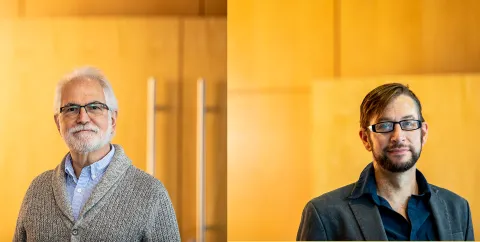
The Lutz Lab’s RNA amplification tests
The Lutz Lab set out to create an inexpensive, easy-to-use COVID-19 test for non-medical sites like schools, daycares and workplaces: Instead of sending swab samples to a lab for processing, people could get results in 30 minutes or less.
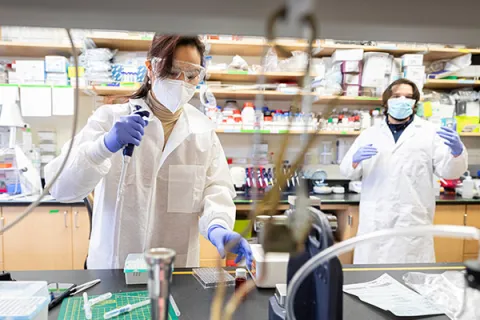
Like the flu, SARS-CoV-2’s genetic material is RNA, a polymer that is similar to DNA but is more fragile and has significant chemical differences. Kline had developed a chemistry that could detect flu RNA, and he quickly modified the sequences in his test to detect three different parts of the SARS-CoV-2 RNA sequence. But he had been using expensive laboratory instruments to detect his flu test results, and he needed a simpler system to use outside the lab. He connected with Mike Roller and Nuttada Panpradist, Lutz Lab researchers behind a low-cost cell-phone-based detector for HIV that could be redesigned for Kline’s new test.
“After Washington’s stay home order went into effect, I’d be home with my three kids during the day. Around 10pm I’d go into the lab and work all night with Mike and Nuttada to get the chemistry to connect with the electronic platform and then use that to inform the device design,” Kline remembers. “We’d go home in the early morning then do it again the next night.”
Soon other students and researchers gravitated to their work, offering to learn new skills to help push the project forward.
“It wouldn’t have been possible if it weren’t for the strong sense of community in Barry’s lab,” Kline says. “Collaboration is key.”
By March, the team had created a $200 prototype that could detect SARS-CoV-2 RNA in under 30 minutes using a nasal swab.
“The entire project was developed by people volunteering their time and expertise,” Lutz recalls. “It came together fast and was amazing to watch.”
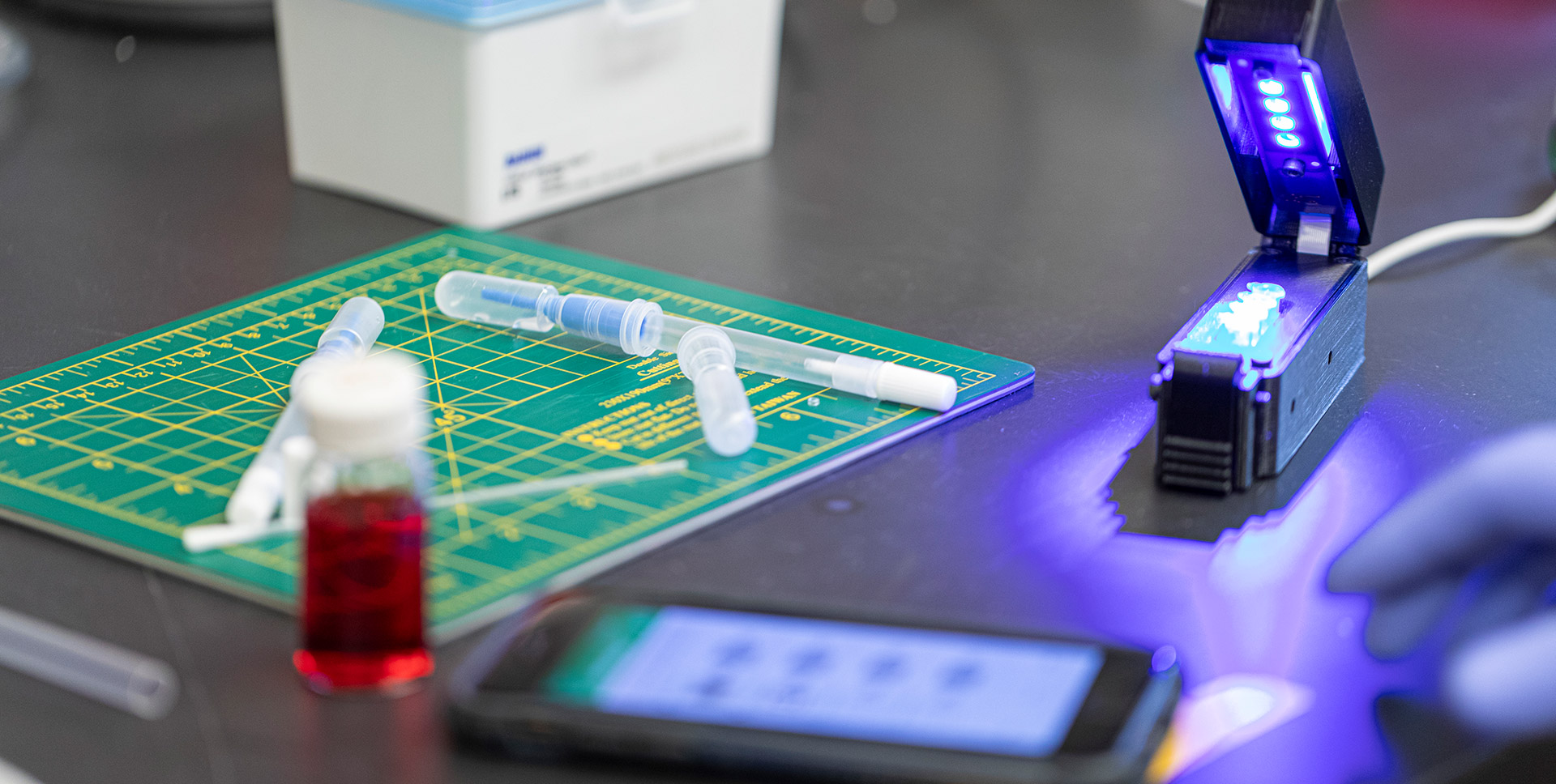
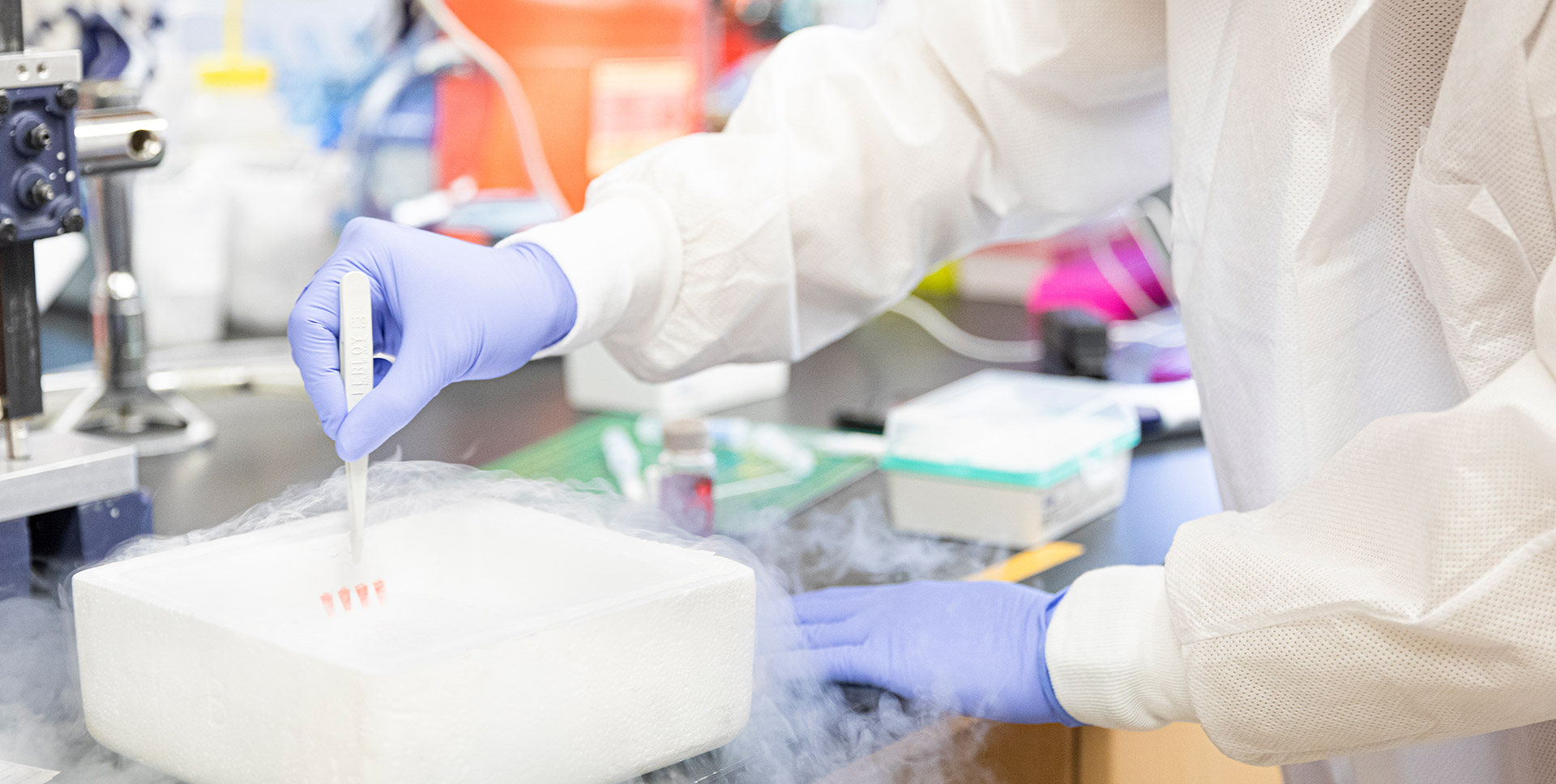
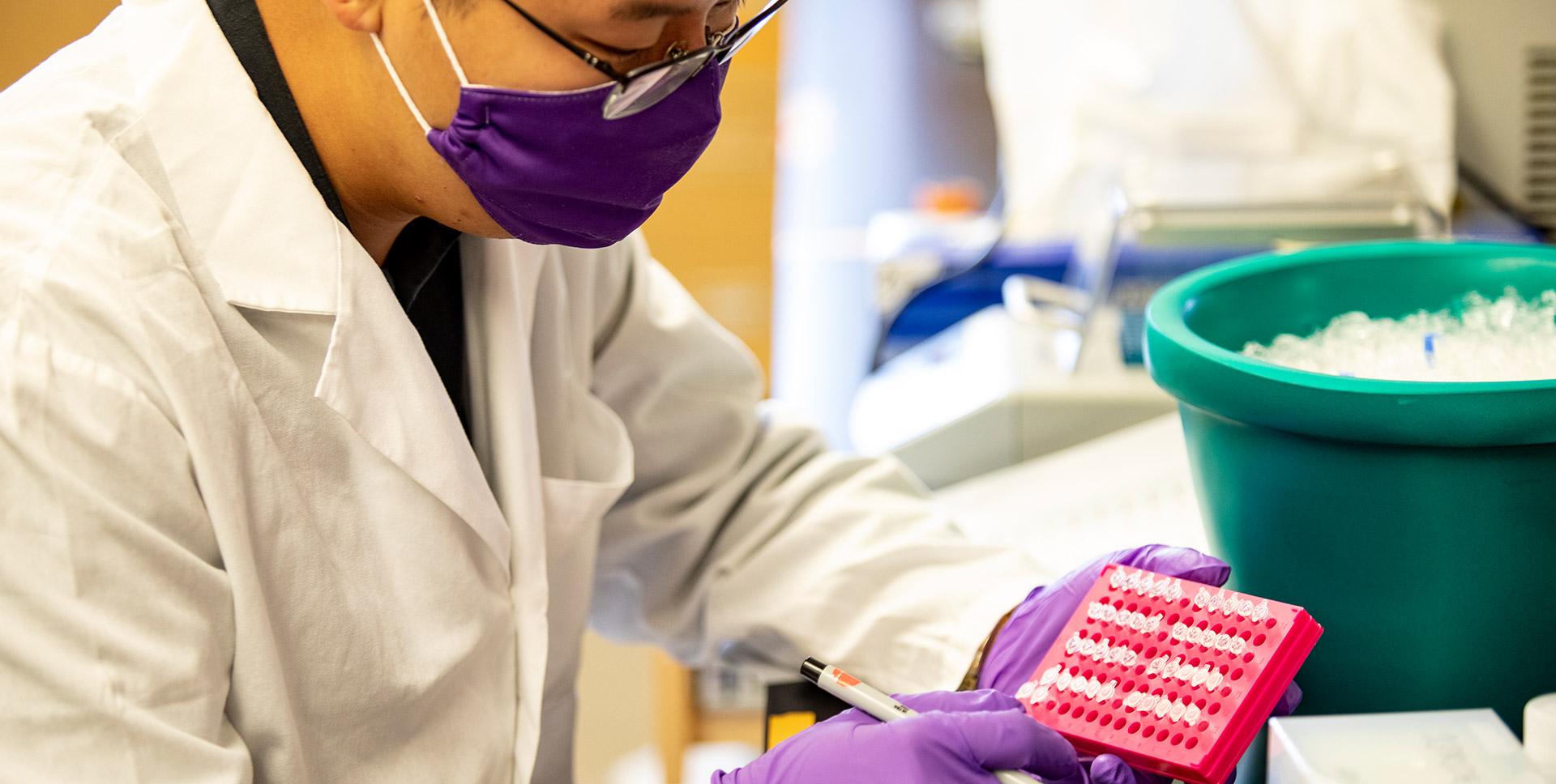
Left: For the Lutz Lab’s prototype, samples are processed in a small black box shown here. Results are available in less than 30 minutes. Top right: Reagents are freeze-dried so they can be shipped and stored at room temperature. This allows the test to be run by just adding a sample to the dried reagents “much like making Ramen noodles,” as Panpradist says. Bottom right: BioE graduate student Kevin Jiang labels SARS-CoV-2 samples in the Yager Lab.
The Yager Lab’s nucleic acid amplification tests
Since 2011, Yager’s lab has been developing compact, low-cost diagnostic tests to detect pathogens — bacteria like staphylococcus aureus (staph) and chlamydia and viruses such as dengue, Zika and HIV. Their approach couples nucleic acid amplification test (NAAT) technology, which makes copies of fragments of a pathogen’s genome, with microfluidic devices to detect the pathogen’s genetic material.
“There are many ways to test for pathogens, but nucleic acid amplification tests are highly sensitive and precise, meaning they are faster than other tests and yield few false-positive results,” Yager explains.
The lab has been applying its technology, called UbiNAAT, to COVID-19 tests for use at home as well as in healthcare facilities and low-resource settings.
The team’s prototype — a six-inch device that communicates with a smartphone — uses a nasal swab or a saliva sample to detect SARS-CoV-2. Users will scan a QR code to download a smartphone app, insert their sample in the device and wait less than 30 minutes for results to appear on their phone. They will have the option to share their results with their primary care doctors, local public health officials, and perhaps even the Centers for Disease Control and Prevention. The UbiNAAT approach is to make the testing process as simple as possible — there are no fluids to add or complex processes to carry out.
An urgent need
Both tests could have major impact on the COVID-19 pandemic, but to do so they need FDA authorization and manufacturing scale-up.

“The challenge is how to get to a million of anything, and how to make it count as soon as possible,” Yager says.
Along with research and testing, the labs have been busy securing funding and identifying potential business partners to develop consumer-ready products.
“There are lots of tests in development right now, which is great, but it also means a lot of competition for limited resources,” Lutz says. “We are continuing to make improvements at the bootstrapping level, but what we really need is funding to move fast and scale up production.”
Both teams have received financial support from regional and national programs to advance their research, but they need more to make an impact. Yager formed a company called UbiDX (short for “ubiquitous diagnostics”) with his partner Kate Sharadin to commercialize the test platform. Lutz’s team received funding from the UW WE-REACH program and founded Anavasi Diagnostics to push their test to FDA authorization.
“There is a huge need for testing, especially at the point-of-care, to help manage this crisis,” Lutz says, “We are rooting for each other to succeed to help fill this testing gap.”
Ultimately, both teams hope to generate tests that will help beyond the immediate problem of COVID-19 — tests that could be used for other at-home disease detection.
“With COVID we have a moment to ask ourselves, why can’t we be doing more home health care? Why must we go to clinics and wait for results when we have the technology to run tests in our homes?” says Yager. “This has the potential to make health care more accessible and more affordable.”
“That’s what we both hope to achieve,” Lutz adds. “If Paul’s project gets the green light, my lab is ready to support his team. It’s really about collaboration for the greater good. We’re all in this together.”
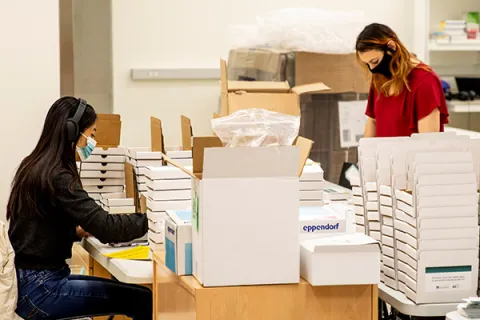
RELATED STORY
UW and the Seattle Flu Study
Barry Lutz, Enos Kline and other UW researchers have been involved with the Seattle Flu Study (SFS), a multi-institutional collaborative launched in 2018 by UW Medicine, the Fred Hutchinson Cancer Research Center, Seattle Children’s, the Institute for Disease Modeling and the Brotman Baty Institute. When COVID-19 arrived in Seattle, SFS partnered with Public Health – Seattle & King County to develop the Seattle Coronavirus Assessment Network (SCAN) to inform Seattle and King County’s coronavirus response.
Through SFS, Lutz partnered with UW professor of family medicine and global health Matthew Thompson to conduct a 2018-19 flu season study mailing flu test kits to people who volunteered to provide nasal swab samples to help track the spread of flu. Because of this experience, their team stepped in to scale up assembly of SCAN’s swab kits. In February 2020, as COVID-19 increased in the region and campus activities tapered off, they set up a swab kit assembly center at the UW Institute for Nano-Engineered Systems (NanoES), powered mainly by a student crew and SFS/SCAN supervisors. The team produced nearly 8,000 SCAN kits in the first two weeks.
The NanoES site has remained the key assembly center throughout the SCAN project; the team estimates they’ve assembled more than 35,000 kits on campus, most of which have been sent to people throughout King County.
In September 2020, the UW launched the Husky Coronavirus Testing program. Powered by SFS, the comprehensive voluntary program aims to quickly identify positive COVID-19 cases on campus; monitor possible spread of the virus; provide a quick and accessible testing resource to anyone experiencing symptoms or with possible exposure; and immediately respond in the event that an outbreak occurs.
Responding to COVID-19
Across the College of Engineering, faculty have pivoted their research to respond to COVID-19.